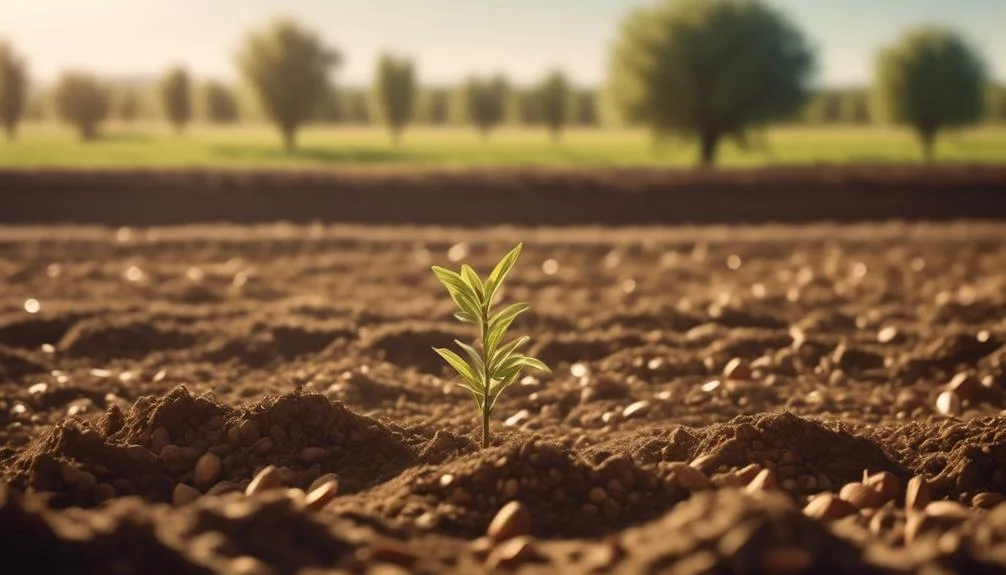Planting almond trees for optimal nut production requires careful consideration of soil, sunlight, water, pollination, and pest control.
The right location is crucial for a successful orchard. But where should you plant your almond trees for the best results? Let's explore the key factors to consider.
Understanding the ideal conditions for planting almond trees will help maximize their nut production potential.
Key Takeaways
- Almond trees thrive in well-draining, deep soils with a pH of 6 to 7.5.
- Almond trees have high potassium requirements, so using a fertilizer with higher potassium content is recommended.
- Proper tree spacing and effective pruning techniques are important to maximize sunlight exposure to leaves and developing nuts.
- Cross-pollination is crucial for successful nut production, and coordinating with beekeepers and nearby orchards can enhance pollination.
Soil Requirements
To ensure successful almond tree growth and nut production, it's essential to understand the specific soil requirements for this crop. Almond trees thrive in well-draining, deep soils with a pH of 6 to 7.5.
Prior to planting, it's crucial to conduct a soil test to determine its nutrient content. Based on the results, appropriate fertilizer application can be determined to meet the tree's specific needs. Almond trees have high potassium requirements, so a fertilizer with a higher potassium content is recommended.
Additionally, incorporating organic matter into the soil can improve its structure and nutrient retention, aiding in the tree's growth and development.
In terms of irrigation methods, almond trees require consistent moisture, especially during the flowering and nut development stages. Drip irrigation is a popular and efficient method, ensuring the trees receive adequate water without excess moisture that can lead to root diseases.
Sunlight Needs
When considering the sunlight needs of your almond trees, it's important to understand how their soil requirements directly influence their ability to harness the energy they need for robust growth and nut production.
Adequate sunlight is crucial for almond trees to thrive and produce a bountiful harvest. Ensure that your trees are planted in an area that receives full sunlight for most of the day.
Proper tree spacing is essential to allow sunlight to reach all parts of the tree, promoting even growth and nut development. Additionally, employing effective pruning techniques can help manage the tree's canopy to maximize sunlight exposure to the leaves and developing nuts.
Watering Needs
Consider the specific watering needs of almond trees to ensure their optimal growth and nut production. Almond trees require careful attention to irrigation techniques due to their moderate drought tolerance. The key is to provide consistent moisture to the root zone while avoiding waterlogging. Here's a table summarizing the irrigation techniques and factors influencing the watering needs of almond trees:
| Irrigation Techniques | Drought Tolerance | Root Zone | Moisture Retention |
|---|---|---|---|
| Drip Irrigation | High | Surface | Mulching |
| Sprinkler Systems | Moderate | Deep | Cover Crops |
| Flood Irrigation | Low | Wide | Soil Amendments |
These techniques and considerations are vital for maintaining the moisture levels essential for the healthy growth and nut production of almond trees.
Pollination Considerations
Have you considered the importance of pollination for the successful nut production of almond trees? Proper pollination is crucial for maximizing almond yields.
Almond trees rely on cross-pollination, which necessitates the presence of bees for effective transfer of pollen between flowers. Bee management is essential during bloom time to ensure adequate pollination. It's important to coordinate with beekeepers to have strong and healthy bee populations available during the flowering period.
Additionally, consider the timing of bloom in nearby orchards. Synchronized bloom timing with neighboring orchards can enhance cross-pollination and improve nut set.
Understanding the pollination requirements of almond trees and actively managing bee activity and bloom synchronization can significantly impact the overall nut production of your almond orchard.
Pest and Disease Control
Maximizing almond yields requires not only effective pollination but also proactive pest and disease control measures to safeguard the health and productivity of your almond orchard. Integrated pest and disease management is crucial for maintaining a thriving orchard.
Encouraging the presence of natural predators, such as ladybugs and lacewings, can help control pest populations. Additionally, implementing cultural practices like proper irrigation and sanitation can reduce disease incidence. When necessary, chemical control options should be used judiciously to minimize negative impacts on the environment and beneficial insects.
Planting resistant varieties can also provide an added layer of protection against common pests and diseases. By employing a holistic approach that integrates natural solutions, cultural practices, and, when needed, carefully selected chemical interventions, you can effectively manage pests and diseases in your almond orchard.
Conclusion
In choosing the right location for planting almond trees, prioritize well-draining soil, ample sunlight, and regular watering for optimal nut production.
Consider pollination needs and be vigilant against pests and diseases to ensure a thriving harvest.
By carefully considering these factors, you can set the stage for a successful almond orchard.
Happy planting!

